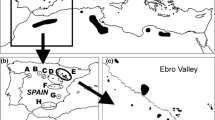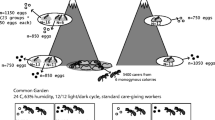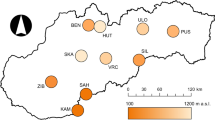Abstract
The variation in size along elevations has been investigated in various insect species, with contradictory results regarding Bergmann’s or James’ rules. Positive, negative, or hump-shaped patterns have been commonly found, but the sources of variation are generally unknown, because the contribution of genetic and environmental factors is not usually estimated. Social insects offer the opportunity to study the intraspecific variation and heritability of morphological traits due to the ease of finding family groups in the wild. Thus, we aimed to assess the variation in morphological characters of Atta cephalotes and to estimate their heritability as an attempt to understand the sources of variation. We sampled 30 soldiers from five nests at six different elevations in Colombia; soldiers were dissected, and ten morphometric characters were measured. Variation was analysed through nested MANOVA and REML analyses, and heritabilities and co-heritabilities were estimated using a full-sib model. We found significant differences between elevations and nests, with larger soldiers occurring at localities in intermediate elevations. Heritabilities varied when they were estimated with all data together or separated by locality, showing low-to-intermediate values, while co-heritabilities were intermediate to high. The nonlinear cline found in this study could be a result of the interactions among the factors generating Bergmann’s patterns, such as temperature, the ecology of leaf-cutting ants (management of temperature inside nests) and resource availability. The heritability results imply a genotype-environment interaction, with an overall greater effect of the environment on body size variation in A. cephalotes soldiers.



Similar content being viewed by others
Data availability statement
The raw data can be accessed through Dryad (Sandoval-Arango 2020).
References
Agrawal AA (2001) Phenotypic plasticity in the interactions and evolution of species. Science 294:321–326
Arnett AE, Gotelli NJ (1999) Geographic variation in life-history traits of the ant lion, Myrmeleon immaculatus: evolutionary implications of Bergmann’s rule. Evolution 53:1180–1188
Bargum K, Boomsma JJ, Sundström L (2004) A genetic component to size in queens of the ant, Formica truncorum. Behav Ecol Sociobiol 57:9–16
Beldade P, Mateus AR, Keller RA (2011) Evolution and molecular mechanisms of adaptive developmental plasticity. Mol Ecol 20:1347–1363
Bergmann K (1847) Über die Verhältnisse der Wärmeökonomie der Thiere zu ihrer Grösse. Göttinger Studien 3:595–708
Bernadou A, Römermann C, Gratiashvili N et al (2016) Body size but not colony size increases with altitude in the holartic ant, Leptothorax acervorum. Ecol Entomol 41:733–736
Bitner-Mathé BC, Klaczko LB (1999) Size and shape heritability in natural populations of Drosophila mediopunctata: temporal and microgeographical variation. Genetica 105:35–42
Blackburn TM, Gaston KJ, Loder N (1999) Geographic gradients in body size: a clarification of Bergmann’s rule. Divers Distrib 5:165–174
Blackburn TM, Ruggiero A (2001) Latitude, elevation and body mass variation in andean passerine birds. Glob Ecol Biogeogr 10:245–259
Bockoven AA, Wilder SM, Eubanks MD (2015) Intraspecific variation among social insect colonies: persistent regional and colony-level differences in fire ant foraging behavior. PLoS ONE 10:e0133868
Brascamp EW, Willam A, Boigenzahn C et al (2016) Heritabilities and genetic correlations for honey yield, gentleness, calmness and swarming behaviour in Austrian honey bees. Apidologie 47:739–748
Brehm G, Fiedler K (2004) Bergmann’s rule does not apply to geometrid moths along an elevational gradient in an Andean montane rain forest. Glob Ecol Biogeogr 13:7–14
Charmantier A, Garant D (2005) Environmental quality and evolutionary potential: lessons from wild populations. Proc R Soc B Biol Sci 272:1415–1425
Chen I-C, Hill JK, Ohlemüller R et al (2011) Rapid range shifts of species associated with high levels of climate warming. Science 333:1024–1026
Chown SL, Gaston KJ (1999) Exploring links between physiology and ecology at macro-scales: the role of respiratory metabolism in insects. Biol Rev 74:87–120
Chown SL, Gaston KJ (2010) Body size variation in insects: a macroecological perspective. Biol Rev 85:139–169
Chown SL, Jumbam KR, Sorensen JG et al (2009) Phenotypic variance, plasticity and heritability estimates of critical thermal limitis depend on methodological context. Funct Ecol 23:133–140
Crozier RH, Bruckner D (1981) Sperm clumpling and the population genetics of Hymenoptera. Am Nat 117:561–563
Cruz CD (2013) GENES—Software para análise de dados em estatística experimental e em genética quantitativa. Acta Sci Agron 35:271–276
Cushman JS, Lawton JH, Manly BFJ (1993) Latitudinal patterns in European ant assemblages: variation in species richness and body size. Oecologia 95:30–37
Della Lucia TM, Gandra LC, Guedes RN (2014) Managing leaf-cutting ants: Peculiarities, trends and challenges. Pest Manag Sci 70:14–23
Dillon ME, Frazier MR, Dudley R (2006) Into thin air: physiology and evolution of alpine insects. Integr Comp Biol 46:49–61
Doebeli M, Dieckmann U (2003) Speciation along environmental gradients. Nature 421:259–264
Diamond SE, Chick L, Perez A et al (2017) Rapid evolution of ant thermal tolerance across and urban-rural temperature cline. Biol J Linn Soc 121:248–257
ESRI (2015) ArcGIS Desktop: release 10.3
Evison SEF, Ratnieks FLW (2007) New role for majors in Atta leafcutter ants. Ecol Entomol 32:451–454
Evison SEF, Hughes WOH (2011) Genetic caste polymorphism and the evolution of polyandry in Atta leaf-cutting ants. Naturwissenschaften 98:643–649
Eweleit L, Reinhold K (2014) Body size and elevation: do Bergmann’s rule and Rensch’s rule apply in the polytypic bushcricket Poecilimon veluchianus? Ecol Entomol 39:133–136
Falconer DS, Mackay TFC (1996) Introducción a la genética cuantitativa. Editorial Acribia, España
García-Ramos G, Kirkpatrick M (1997) Genetic models of adaptation and gene flow in peripheral populations. Evolution (N Y) 51:21–28
Geraghty MJ, Dunn RR, Sanders NJ (2007) Body size, colony size, and range size in ants (Hymenoptera: Formicidae): are patterns along elevational and latitudinal gradients consistent with Bergmann’s Rule? Myrmecol News 10:51–58
Gómez-Lopera N, López-Gallego C (2014) Estimación de heredabilidad y correlaciones genéticas en caracteres morfológicos y fisiológicos para una población de Zamia obliqua A.Br. (Zamiaceae: Cycadales). Actualidades Biol 36:137–148
Guariguata MR, Ostertag R (2001) Neotropical secondary forest succession: changes in structural and functional characteristics. For Ecol Manage 148:185–206
Haatanen M-K, Sorvari J (2014) Similarity of body size in queens of the wood ant Formica aquilonia from optimal and sub-optimal habitats indicates a strong heritable component. J Insect Sci 13:1–11
Hawkins BA, Devries PJ (1996) Altitudinal gradients in the body sizes of Costa Rican butterflies. Acta Oecol 17:185–194
Hawkins BA, Lawton JH (1995) International association for ecology latitudinal gradients in butterfly body sizes: is there a general pattern? Oecologia 102:31–36
Helanterä H, Ratnieks FLW (2008) Geometry explains the benefits of division of labour in a leafcutter ant. Proc R Soc B Biol Sci 275:1255–1260
Hodkinson ID (2005) Terrestrial insects along elevation gradients: species and community responses to altitude. Biol Rev Camb Philos Soc 80:489–513
Hölldobler B, Wilson EO (1990) The ants. Springer, Berlin
Horne CR, Hirst AG, Atkinson D (2018) Insect temperature–body size trends common to laboratory, latitudinal and seasonal gradients are not found across altitudes. Funct Ecol 32:948–957
Hughes WOH, Sumner S, Van Borm S et al (2003) Worker caste polymorphism has a genetic basis in Acromyrmex leaf-cutting ants. Proc Natl Acad Sci 100:9394–9397
Hughes WHO, Bot ANM, Boomsma JJ (2009) Caste-specific expression of genetic variation in the size of antibiotic-producing glands of leaf-cutting ants. Proc R Soc B Biol Sci 277:609–615
Janssens MJJ (1979) Co-heritability: Its relation to correlated response, linkage, and pleiotropy in cases of polygenic inheritance. Euphytica 28:601–608
James FC (1970) Geographic size variation in birds and its relationship to climate. Ecology 51:365–390
Kenward M, Roger J (1997) Small sample inference for fixed effects from restricted maximum likelihood. Biometrics 53:983–997
Lindman RH (1974) Analysis of variance in complex experimental design. W. H, Freeman and Co, New York
Linksvayer TA (2006) Direct, maternal, and sibsocial genetic effects on individual and colony traits in an ant. Evolution 60:2552–2561
Mattila HR, Seeley TD (2007) Genetic diversity in honey bee colonies enhances productivity and fitness. Science 317:362–364
Mondino VA, Pastorino MJ, Gallo LA (2019) Variación altitudinal de caracteres fenológicos y crecimiento inicial en condiciones controladas entre poblaciones de Nothofagus pumilio provenientes del centro-oeste de Chubut, Argentina. Bosque 40:87–94
Montoya-Lerma JM, Chacón De Ulloa P, del Manzano MR (2006) Characterization of the nests of the leaf-cutting ant Atta cephalotes (Hymenoptera: Myrmicinae) in Cali (Colombia). Rev Colomb Entomol 32:151–158
Mousseau TA (1997) Ectotherms follow the converse to Bergmann’s Rule. Evolution 51:630–632
Oldroyd BP, Fewell JH (2007) Genetic diversity promotes homeostasis in insect colonies. Trends Ecol Evol 22:408–413
Owen RE, Harder LD (1995) Heritable allometric variation in bumble bees: opportunities for colony-level selection of foraging ability. J Evol Biol 8:725–738
Rodríguez-Jimenez A, Sarmiento CE (2008) Altitudinal distribution and body resource allocation in a High Mountain social wasp (Hymenoptera: Vespidae). Neotrop Entomol 37:1–7
R Core Team (2018) R: A language and environment for statistical computing. R Foundation for Statistical Computing, Vienna, Austria
Sandoval-Arango S (2020) RawData_Sandoval_et_al_Divergence_in_Bergmann_clines_leaf-cutting_ant Dryad. Dataset. https://doi.org/10.5061/dryad.jsxksn06d
Shelomi M (2012) Where Are We Now? Bergmann’s Rule Sensu Lato in Insects. Am Nat 180:511–519
Stürup M, den Boer SPA, Nash DR et al (2011) Variation in male body size and reproductive allocation in the leafcutter ant Atta colombica: estimating variance components and possible trade-offs. Insect Soc 58:47–55
Vinarski MV (2014) On the applicability of Bergmann’s rule to ectotherms: the state of the art. Biol Bull Rev 4:232–242
Visscher PM, Hill WG, Wray NR (2008) Heritability in the genomics era-concepts and misconceptions. Nat Rev Genet 9:255–266
Van Voorhies WA (1996) Bergmann size clines: a simple explanation for their occurrence in ectotherms. Evolution 50:1259–1264
Waddington SJ, Santorelli LA, Ryan FR et al (2010) Genetic polyethism in leaf-cutting ants. Behav Ecol 21:1165–1169
Warzecha D, Diekötter T, Wolters V et al (2016) Intraspecific body size increases with habitat fragmentation in wild bee pollinators. Landscape Ecol 31:1449–1455
Wetterer JK (1999) The ecology and evolution of worker size-distribution in leaf-cutting ants (Hymenoptera: Formicidae). Sociobiology 34:119–144
Wickham H (2016) ggplot2: elegant graphics for data analysis. Springer, New York
Yang AS, Martin CH, Nijhout HF (2004) Geographic variation of caste structure among ant populations. Curr Biol 14:514–519
Acknowledgements
We thank Inge Armbrecht, Cristina Gallego, Lucimar Dias, Shirley Palacios, Hernando Vallejo, and Sergio Martínez for their support and assistance with field work. Special thanks to the workers at UMATA in Santa Rosa de Cabal and the National Association of Coffee Growers in Palestina for helping in finding nest sites. We are also grateful to Carlos Sarmiento from UNAL and students in the GEANHA and Ant Ecology research groups at Universidad del Valle for comments and suggestions that improved this manuscript. We thank the Laboratorio de imágenes of postgrado Ciencias-Biología, Universidad del Valle and Juan Felipe Ortega for helping in taking pictures for Fig. 2, and Mauro Zucconi for helping with R Studio and the ggplot2 package used to create Fig. 3. Finally, we thank three anonymous reviewers for comments that improved the manuscript.
Author information
Authors and Affiliations
Corresponding author
Electronic supplementary material
Below is the link to the electronic supplementary material.
Rights and permissions
About this article
Cite this article
Sandoval-Arango, S., Cárdenas Henao, H. & Montoya-Lerma, J. Divergence in Bergmann’s clines: elevational variation and heritability of body size in a leaf-cutting ant. Insect. Soc. 67, 355–366 (2020). https://doi.org/10.1007/s00040-020-00771-8
Received:
Revised:
Accepted:
Published:
Issue Date:
DOI: https://doi.org/10.1007/s00040-020-00771-8




